| dc.description.abstract | This study explores the combination of photovoltaic (PV) panels with a reflector mounted on a building to improve electricity generation. Globally, PV panels have been widely used as a renewable energy technology. In order to obtain more solar irradiance and improve electricity output, this study presents an advanced strategy of a reflector combining PV panels mounted on a building in Calgary, Canada. Based on an experimental database of solar irradiances, the simulation presents an optimal shape designed and tilt angles of the reflector and consequently improves solar radiation gain and electricity outputs. Polished aluminum is selected as the reflector material, and the shape and angle are designed to minimize the interruption of direct solar radiation. The numerical approach demonstrates the improvement in performance using a PV panel tilted at 30◦ , 45◦ , 60◦ , and 75◦ and a reflector, tilted at 15.5◦ or allowed to be tilted flexibly. A reflector tilted at 15.5◦ can improve solar radiation gains, of the panel, by nearly 5.5–9.2% at lower tilt angles and 14.1–21.1% at higher tilt angles. Furthermore, the flexibly adjusted reflector can improve solar radiation gains on the PV panel, by nearly 12–15.6% at lower tilt angles and 20–26.5% at higher tilt angles. A reflector tilted at 15.5◦ improves the panel’s output electricity on average by 4–8% with the PV panel tilted at 30◦ and 45◦ respectively and 12–19% with the PV panel tilted at 60◦ and 75◦ , annually. Moreover, a reflector that can be flexibly tilted improves electricity output on average by 9–12% with the PV panel tilted at 30◦ and 45◦ and 17–23% with the PV panel tilted at 60◦ and 75◦ . Therefore, the utilization of a reflector improves the performance of the PV panel while incurring a relatively low cost. | en_US |

